Chicken Coop Lighting for Egg Production
Do your hens lay fewer eggs when daylight fades in winter? You’re not alone. Shorter days send a signal to your flock’s biological clock telling them it’s time to slow down egg production. But here’s the good news—this natural decline isn’t permanent, and it’s completely fixable with the right chicken coop lighting for egg production.
In this guide, you’ll learn how to set up a lighting system that mimics ideal daylight conditions—all without expensive equipment or complicated wiring. You’ll discover:
✅ The scientifically proven light duration, brightness, and spectrum for maximum egg production
✅ A step-by-step coop lighting setup you can copy today
✅ The best red-spectrum LED lights and timer systems for consistent results
✅ Seasonal lighting plans to keep your hens laying all year long
Let’s shed some light—literally—on how to get your flock back to peak productivity.
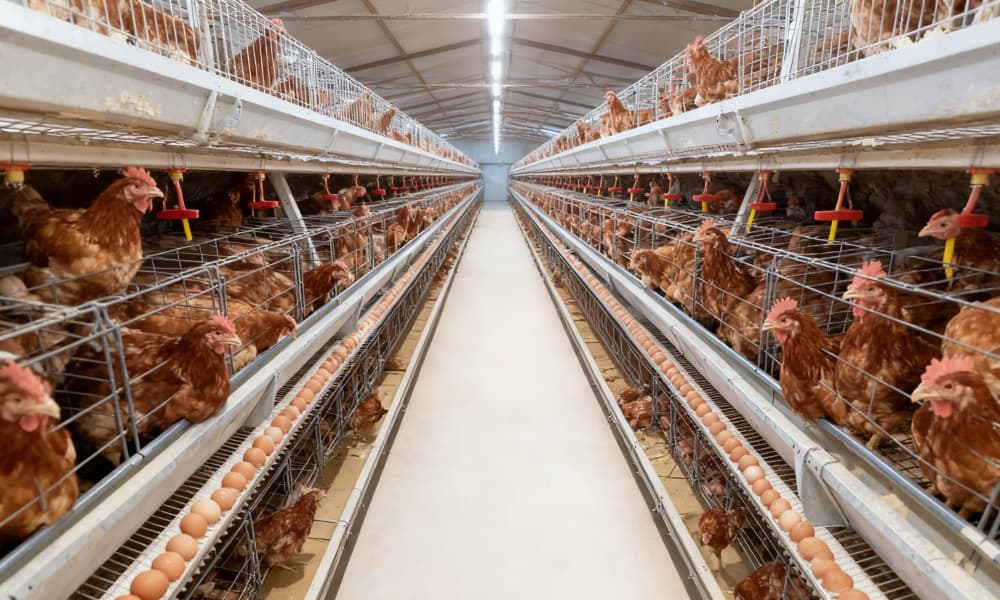
Table of Contents
How Light Controls Egg Production in Chickens
How Light Affects Egg Laying – The Science Explained
The Three Pillars of Productive Chicken Coop Lighting
Step-by-Step Chicken Coop Lighting Setup Plan
Seasonal Chicken Coop Lights Guide (Winter, Summer, Spring/Fall)
Top 3 Chicken Coop Lighting Mistakes and Solutions
How Light Controls Egg Production in Chickens?
Do your hens suddenly stop laying when winter comes? It’s not because they’re sick or too cold—it’s because their bodies respond to light, not temperature.
Chickens are light-sensitive animals. When daylight drops below about 12 hours, their internal clock sends a signal to slow down or completely pause egg production. This is a natural survival instinct, but it becomes a problem when you rely on steady egg output.
The good news? You can control this switch.
By providing the right amount of artificial light each day—without changing feed, breed, or housing—you can keep hens laying normally even in the darkest months.
Just 14–16 hours of light per day can restart laying within 1–2 weeks.
No major barn renovation is needed—only proper light duration, brightness, and spectrum.
Results are proven: farms consistently see a 15–30% increase in egg production with correctly managed lighting.
Next, let’s break down the science behind how light activates a hen’s reproductive system—so you know exactly why this method works.
Why Light Affects Egg Laying – The Science Explained
Light is not just about visibility for chickens — it is the master switch that controls their reproductive system. To understand why lighting works so effectively in boosting egg production, we need to explore how hens perceive light and how their bodies respond hormonally.
1. Photoperiod & Hen’s Biological Clock – Why 14–16 Hours is the Sweet Spot
Chickens are photoperiodic animals, which means their bodies respond to changes in daylight length. In nature, hens lay more eggs in spring and summer when the days are long and stop laying in fall and winter when days get shorter.
But why exactly 14–16 hours of light?
Below 12 hours → hens shift into “rest mode,” conserving energy instead of producing eggs.
Between 14–16 hours → light is strong enough to activate the reproductive system fully.
More than 16 hours → no extra eggs are produced, and the excess light may cause stress or feather pecking.
This 14–16 hour light cycle syncs with a hen’s internal circadian rhythm and signals her body that it’s the ideal season to reproduce.
2. Light → Brain → Hormones → Eggs
The poultry lighting science behind egg production begins with light reaching specialized photoreceptors in the hen’s brain—not just the eyes. Here is the simplified chain reaction:
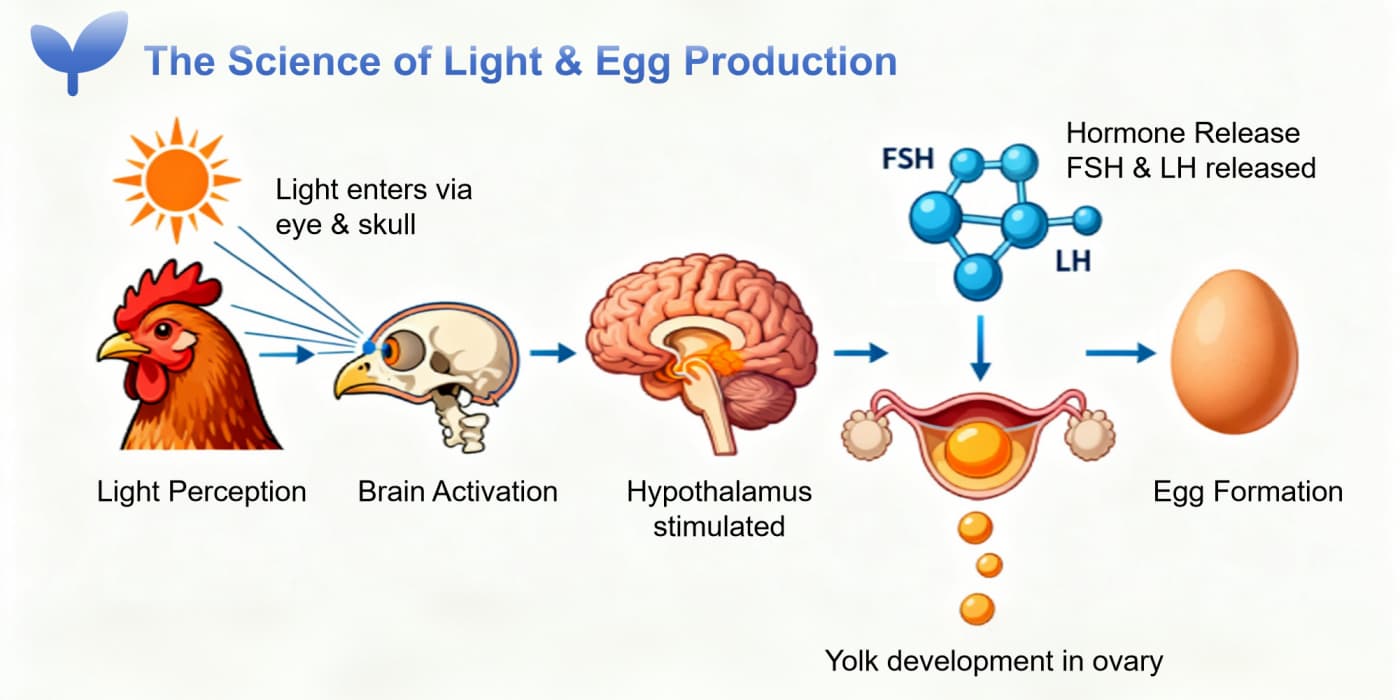
Step 1: Light enters through the eyes and skull
Chickens can sense light through both the retina and thin cranial skin.
Step 2: Hypothalamus activation
Light stimulates the hypothalamus, a part of the brain responsible for regulating biological functions like reproduction.
Step 3: Pituitary gland releases hormones
The hypothalamus triggers the pituitary gland to release two key reproductive hormones:
FSH (Follicle-Stimulating Hormone) – stimulates ovary follicles to grow yolks
LH (Luteinizing Hormone) – triggers ovulation and egg release
Step 4: Egg production begins
Once yolks mature, they move through the oviduct, where albumen, membranes, and the shell form—producing one egg approximately every 24–26 hours.
✅ This process only continues if light exposure is consistent and long enough each day.
3. Why Hens Stop Laying in Winter
In winter, two major environmental factors work against egg production:
Winter Factor | Effect on Hens | Consequence |
Shorter daylight (<12h) | Hypothalamus receives insufficient light | FSH & LH production decreases |
Cold temperatures | Hen’s body prioritizes warmth and survival | Less energy for egg formation |
Natural seasonal instinct | Hens conserve nutrients for health, not reproduction | Egg laying slows or stops |
When daylight drops below 12 hours, hormone levels decline, follicles stop developing, and egg output decreases dramatically.
But this is not a permanent biological shutdown — it’s simply a response to light loss. With artificial lighting that restores 14–16 hours of consistent light, hormone activity resumes, and the laying process restarts naturally.
4. What Research and Production Indicators Show
Studies on chicken coop lighting reveal practical effects on production, presented here as actionable takeaways for farmers and backyard keepers:
Indicator | Key Takeaways for Egg Producers |
Average Egg Production Rate | Consistent 14–16h light helps maintain higher production. Over months, daily laying stays more stable compared to natural light alone. |
Average Egg Weight | Egg weight may slightly decrease if light exposure increases but diet is unchanged. Ensure sufficient protein and calcium to maintain optimal egg size. |
Soft Egg Rate | Gradual, stable light reduces soft-shelled eggs. Red-spectrum light is especially effective in minimizing shell defects. |
Egg Breaking Rate | Evenly distributed LED lighting lowers breakage by reducing stress and crowding around feeders or nest boxes. |
Practical Tip: Pair proper lighting with balanced nutrition and gradual light transitions to maximize egg output and maintain egg quality.
The Three Pillars of Productive Chicken Coop Lighting
To boost egg production, poultry lighting must go beyond simply “turning on a bulb.” Three elements determine whether your flock lays consistently year-round: light duration, light intensity, and light spectrum. Get these right, and most hens will resume laying within 7–14 days.

1. Light Duration – Maintain 14–16 Hours of Light Every Day
Light duration (also called the photoperiod) is the most critical factor for triggering egg production. Hens need 14–16 hours of continuous light daily to keep their reproductive hormones active.
✅ Why Consistency Matters
Light must be added gradually—no sudden jump from 8 to 16 hours.
Abrupt changes can confuse the hen’s biological clock, causing stress, feather loss, or a complete stop in laying.
The recommended method is to increase light by 30 minutes per week until reaching 14–16 hours.
✅ Why You Need an Automatic Timer
Keeping a manual schedule is nearly impossible—missing even a single morning or evening light session can reset the hen’s internal clock.
➡ Recommended solution:
“This is where an automatic controller, like the Ceramiclite IDS Controller, becomes essential. It delivers precise daily lighting schedules—turning lights on and off at the exact time, without you lifting a finger.”
2. Light Intensity – 5–10 Lux Is All You Need
Hens don’t need bright, harsh light. In fact, too much light can cause stress and aggression. Research shows that 5–10 lux—roughly the brightness of early morning sunlight—is ideal for egg production.
✅ What Is Lux?
Lux measures how much visible light reaches a surface.
5 lux = a dim hallway
10 lux = soft indoor lighting
✅ How to Measure Lux in Your Coop
You don’t need a laboratory tool—just a smartphone and a free light meter app.
Stand at the height of the chickens' heads.
Check several spots—nesting area, perches, corners.
Aim for even coverage with no dark shadows or bright glare.
✅ Best Lighting Fixtures for Even Coverage
➡ “To achieve shadow-free, balanced lighting across the coop, we recommend using D80 LED Light Bulb and T5 LED Barn Light. Their wide beam angle, low glare, and stable output make them ideal for poultry environments.”
D80 LED Light Bulb T5 LED Barn Light
3. Light Spectrum – Red Light Stimulates More Egg Production
Not all light colors affect hens the same way. Red light (620–750 nm) has been proven to stimulate the reproductive system more effectively than blue or cool white light.
✅ Why Red Light Works
Red wavelengths penetrate deeper through the skull, reaching the hypothalamus.
This stimulates the pituitary gland to release more FSH and LH hormones, which are essential for egg production.
Red light also reduces melatonin levels (the sleep hormone), keeping hens active and laying.
✅ Red vs. White vs. Blue Light
Light Type | Effect on Hens | Recommended? |
Blue Light | Calming, reduces movement | ✔ For brooders, ✖ Not for egg production |
White Light (Cool/Neutral) | General visibility, moderate effect on laying | ✔ Acceptable |
Red Light (620–750 nm) | Strong stimulation of reproductive hormones, reduces stress | ✅ Best for egg production |
✅ Recommended Product
➡ “For optimal laying performance, use the Ceramiclite D80 LED Bulb (Red Spectrum). It delivers a scientifically calibrated red wavelength that supports egg production while keeping hens calm and comfortable.”
Step-by-Step Chicken Coop Lighting Setup Plan
To turn lighting into real egg production—not just bright barns—you need a structured setup. This chapter walks you through everything: choosing the right fixtures, installing them correctly, and automating the light cycle for consistent egg laying.
✅ Step 1: Calculate Coop Size & Select the Right Fixtures
Different coop sizes and ceiling heights require different lighting fixtures and quantities.
Coop Size | Area | Recommended Fixture | Quantity (per 10 m²) | Notes |
Small | < 10 m² | Ceramiclite T5 LED Tube | 1–2 units | Low ceiling, easy wiring |
Medium | 10–30 m² | Ceramiclite T8 LED Tube | 2–4 units | Most backyard coops |
Large | 30–60 m² | T8 + T5 combination | 4–6 units | Avoid dark corners |
Large Barn / High Ceiling | >60 m² or >3 m height | Ceramiclite T21 LED Barn Light | 1 unit per 20–25 m² | Better brightness and coverage |
Why T21 for barns?
It provides higher lumen output, wider light spread, and works better for coops with higher ceilings (>3 m), ensuring light reaches the floor and nesting areas.
| LED Barn Light T5 | LED Barn Light T8 |
 | 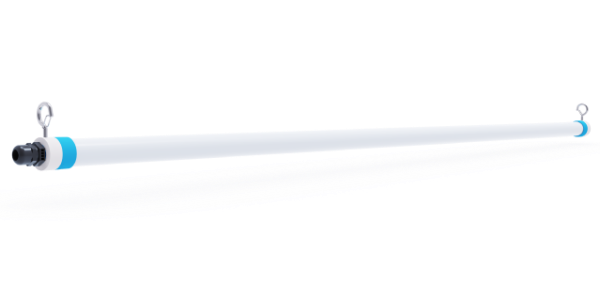 |
| LED Light Bulb D80 | LED Barn Light T21 |
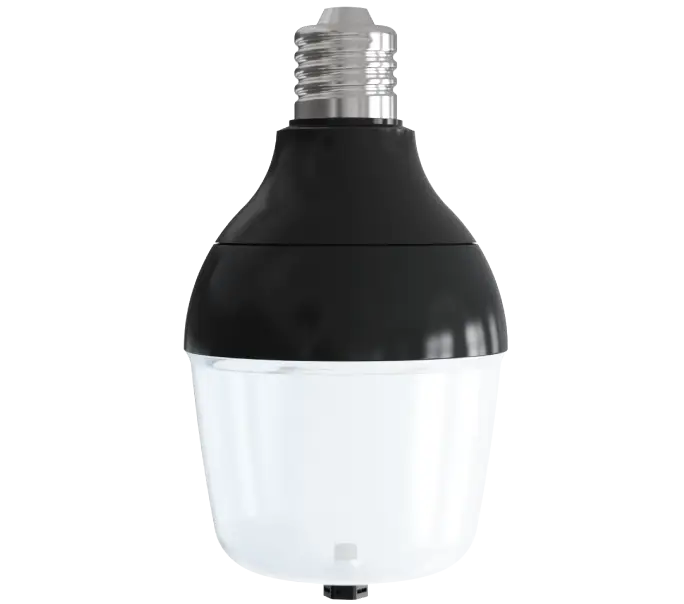 | 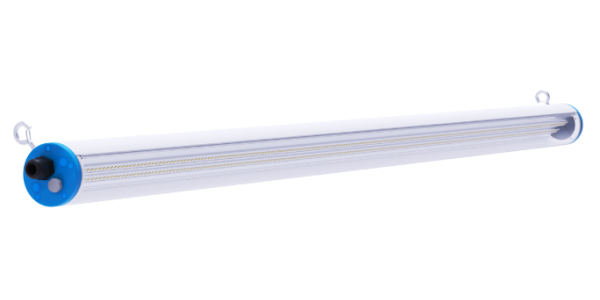 |
✅ Step 2: Optimal Light Placement & Mounting Height
Goal: Uniform light distribution with no shadows or dim areas.
Setup Element | Recommendation |
Mounting Height | 2–2.5 m in small/medium coops; 3–4 m in barn-style houses |
Layout Style | Linear rows for narrow/coffin-style coops; grid layout for large barns |
Spacing Between Lights | 1.5–2 m between T5/T8 tubes; 3–4 m between T21 fixtures |
Avoid | Direct light into chickens’ eyes, dark feeding or nesting areas |
Ensure light reaches feeders, roosting bars, and nest boxes—these are the most active areas for eating and egg laying.
✅ Step 3: Automation – Timers & Gradual Light Increase
Manual switching is unreliable and disrupts hens’ hormonal rhythm. Automation is essential for stable egg production.
✔ What to Set Up:
Use automatic timers or IDS Smart Controller
Turn lights on before sunrise (e.g., 4:30 AM in winter)
Extend light in the evening after sunset to maintain 14–16 hours total light
⚠ Why gradual increase matters:
Jumping from 10 h to 16 h of light in one day stresses hens and can temporarily stop egg laying.
✔ Correct method: Increase light by 15–30 minutes per week.
✅ Example Winter Light Schedule
Week | Total Light Hours | Suggested Timer |
Week 1 | 12 h | Lights on 5:30 AM – 7:00 AM |
Week 2 | 12.5 h | Lights on 5:15 AM – 7:15 AM |
Week 3 | 13 h | Lights on 5:00 AM – 7:30 AM |
Week 4 | 14 h | Lights on 4:30 AM – 8:00 PM |
✅ Summary Checklist
✔ Choose the correct lighting (T5, T8, or T21 based on coop size and height)
✔ Install lights evenly with no dark zones
✔ Mount at the right height for full coverage
✔ Use timers and increase lighting duration gradually
Seasonal Chicken Coop Lights Guide (Winter, Summer, Spring/Fall)
Light needs change with the seasons. Even if you’ve set up the perfect system, failing to adjust it throughout the year can lead to stress, dropped egg production, or overstimulation. Use this seasonal guide to keep your flock laying consistently and comfortably.
1. Winter – Add Morning or Evening Light to Maintain 14–16 Hours
Winter days are short, often dropping to 8–10 hours of natural daylight. Without supplemental lighting, hens will naturally stop laying.
Lighting Strategy:
✔ Add artificial light in the early morning (e.g., start at 5:00–6:00 a.m.) or early evening.
✔ Keep total light exposure between 14–16 hours per day.
Why Morning Light Is Better:
Evening-only lighting can suddenly switch off, leaving hens in darkness before they perch—causing stress.
Morning light mimics sunrise naturally and helps chickens wake up gradually.
Key Winter Tips:
Use an automatic timer or IDS Controller to prevent human error.
Increase light duration slowly—no more than 30 minutes per week.
Ensure the coop remains dry and draft-free; light alone cannot compensate for poor housing.
2. Summer – Prevent Overexposure and Heat Stress
Summer naturally provides long daylight—sometimes more than 15–16 hours. Adding more light won’t increase egg production and can overstimulate hens.
Lighting Strategy:
✔ Do not exceed 16 hours of total light.
✔ Provide natural shading or blackout curtains if daylight is too long.
Key Summer Tips:
Over 16 hours of light can increase aggression, pecking, and stress.
Maintain proper ventilation—light increases activity, which means more heat.
Avoid very bright light; 5–10 lux is still enough even in summer.
3. Spring & Fall – Transition Seasons = Gentle Adjustments
Spring and fall are the best times to adjust lighting gradually and prepare hens for seasonal changes.
Lighting Strategy:
✔ Adjust light by +30 minutes per week until you reach 14–16 hours.
✔ Always make changes at the same time every week—consistency is key.
Key Spring/Fall Tips:
In early fall, start adding light before hens naturally stop laying.
In spring, maintain consistent lighting to avoid hormonal fluctuations.
Avoid sudden lighting reductions—it may cause molting or disrupt egg cycles.
✅ Seasonal Lighting Summary Table
Season | Lighting Strategy | Key Tips |
Winter | Add morning/evening light to reach 14–16h | Use timers; avoid sudden lights-off; increase gradually |
Summer | Keep light ≤16h total; provide shade | Prevent heat stress & overstimulation |
Spring / Fall | Adjust light by +30 min/week | Smooth transitions; maintain consistency |
Top 3 Chicken Coop Lighting Mistakes and Solutions
Even experienced poultry keepers make lighting mistakes that reduce egg production. The good news? Most of them are easy to fix.
(1) Inconsistent Lighting Schedule
⚠ Problem:
Lights are turned on/off manually or at random times. This disrupts the hens’ biological rhythm and reduces FSH (Follicle-Stimulating Hormone) production, leading to irregular or stopped egg laying.
✔ Solution:
Use automatic timers or IDS intelligent controllers to maintain a consistent 14–16-hour light cycle.
Gradually increase light duration by 15–30 minutes per week instead of sudden changes to avoid stress.
(2) Wrong Light Spectrum (Too White or Too Blue)
⚠ Problem:
Many chicken coops use cool white or blue LED lights. These wavelengths suppress melatonin and do not effectively stimulate the hypothalamus and pituitary gland, resulting in poor egg production.
✔ Solution:
Use red spectrum lighting (620–750 nm) to stimulate reproductive hormones more effectively.
Recommended product: D80 Red Spectrum LED Bulb — optimized for laying hens and safe for long-term exposure.
(3) Uneven or Insufficient Light Intensity
⚠ Problem:
Dark corners in the coop or light levels below 5 lux make hens stay inactive, avoid feeding areas, and reduce laying. Overly bright light (>20 lux) can also cause aggression and pecking.
✔ Solution:
Ensure even light distribution at 5–10 lux throughout the coop.
Use Ceramiclite T5, T8, or T21 LED tube lights for wide-angle, flicker-free illumination.
Position lights at ceiling level, evenly spaced, and measure brightness using a smartphone lux meter app.
Key Takeaway:
Stable timing + correct spectrum + proper brightness = 15–30% higher egg production without expensive equipment.
Conclusion
Light isn’t just about visibility in the chicken coop — it’s a biological switch that controls hormones, egg formation, and overall flock productivity. When light duration, intensity, and spectrum are set correctly, hens lay more consistently, stay healthier, and maintain production year-round, even in winter.
By applying the right lighting strategy, you gain:
More eggs: 15–30% increase within 1–2 weeks.
Healthier hens: Reduced stress, better immunity, fewer laying breaks.
Predictable productivity: No more seasonal drops or random laying patterns.
Light smart. Farm smarter. Let your hens lay at their full potential — every season, every day.
Ceramiclite is always here to help you!

_thumb.jpg)